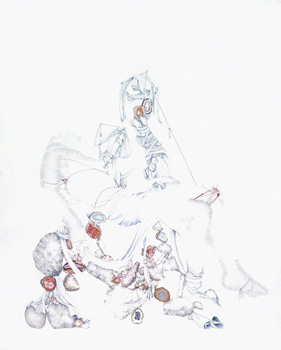
Aesthetic transcendence is a delusion, according to the current thinking of aesthetic agnostics or atheists, but art-lovers still seek the old epiphanies, often in vain. Colleen Sanders' paintings roll away the stone and raise again the once-dead issues of religious mystery in art, but casually, without sermonizing. "Stilling," the title of her small show at Eleanor Harwood Gallery, suggests the ego becalmed by meditation or prayer. Her cult of art is both serious and playful: one painting not on display is entitled Eye and Thou, a wordplay on theologian Martin Buber's 1937 book "I and Thou" about living in worlds of objects or world of relationships.
Sanders' paintings depict aggregations of natural materials--branches, strings, threads, pins, spheres, knots, ruffled cloth, tentacular cascades of hair, geodes, flowers, grasses, and other miscellanea (shells? fungi? artifacts?). These elements have seemingly been draped over familiar religious statues. With those armatures removed, the remaining assemblages, reminiscent of the humanoid figures in Surrealist exquisite-corpse composite drawings, or perhaps shed insect shells, become haunting absences; they could almost be symbols of dead faiths if not so beautifully rendered. Three huge unframed pieces dominate the space: Chord/cord/cored, with its homophonic suggestion of ambivalence and transformation, based on a stalwart Japanese guardian figure; Untitled (Pieta), based on Michelangelo's marble Lamentation; and Untitled (Kanon), possibly based on Buddhist prototypes. Three smaller works take their inspiration from other art-historical lore: the rabbit skull at the base of the cruciform Untitled (Rabbit Skull), for example, paraphrases the oft-depicted skull of Adam at Calvary.
For all their arcane lore, Sanders' images also split the difference between representation and abstraction, between object and symbol. Gallerist Eleanor Harwood: "An image of hair not only suggests beauty, sex, death, the abject, etc., but it also can shift and be read as musculature, water, or vegetation." Buber and Sanders would seem to agree that the universe is alive, not a clockwork, however complicated or intelligently designed.
